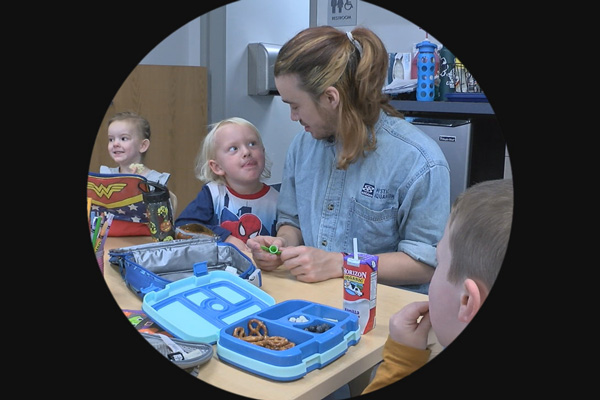Flexible Mealtimes in a Part-Day Program:
Supporting Children to Listen to Their Own Hunger Cues
(This video has captions. You can turn them on by clicking the CC icon at the bottom of the video.)Download a printable transcript in English and Spanish.
Child: Blueberries!
Anne Marie Boroughs, Director and Lead Teacher, The Sea School: We decided very early on that we didn’t want hungry children. Preschoolers do not function well when they’re hungry, and it’s really important and a really huge part of our nutritional curriculum to have children eat when they’re hungry and stop when they’re full.
Child: I’m super hungry. I just want to eat.
Anne Marie Boroughs: Like any other aspect of our program, we have a lot of freedom within parameters. So, the parameter is you have to wash your hands and eat at a clean table. And they eat when they’re hungry, and when they’re full, they pack it up put it away. And if they go running around on the green and they get hungry again, they can access their lunch, you know, when we get back to the classroom. Anybody’s hungry or thirsty, they can just take care of those needs.
Anne Marie Boroughs: No matter what time of day it is, if there’s children sitting at the table eating, we’ll sit down with them.
Teacher: Are those raisins? Covered in yogurt? Nice.
Anne Marie Boroughs: What we’ve found is they’re very responsible. And they’re also still socializing.
Child: I got blueberries, too!
Anne Marie Boroughs: We do find that some classes tend to be really hungry earlier in the day, so we just adjust and we’re flexible in that regard. I know once they go off to public school, there’s going to be a lunch time, but they’re going to be older and in a very different developmental stage in life.
Child: Mia! I put it in! I put it in myself!
Anne Marie Boroughs: What we’re trying to give children opportunities to do is understand their bodies and their body’s needs. I can’t see any reason why they shouldn’t be able to take care of their own nutritional needs. And they thrive with it.
© 2021 Center for Early Childhood Education at Eastern Connecticut State University.
May be reprinted for educational purposes.



